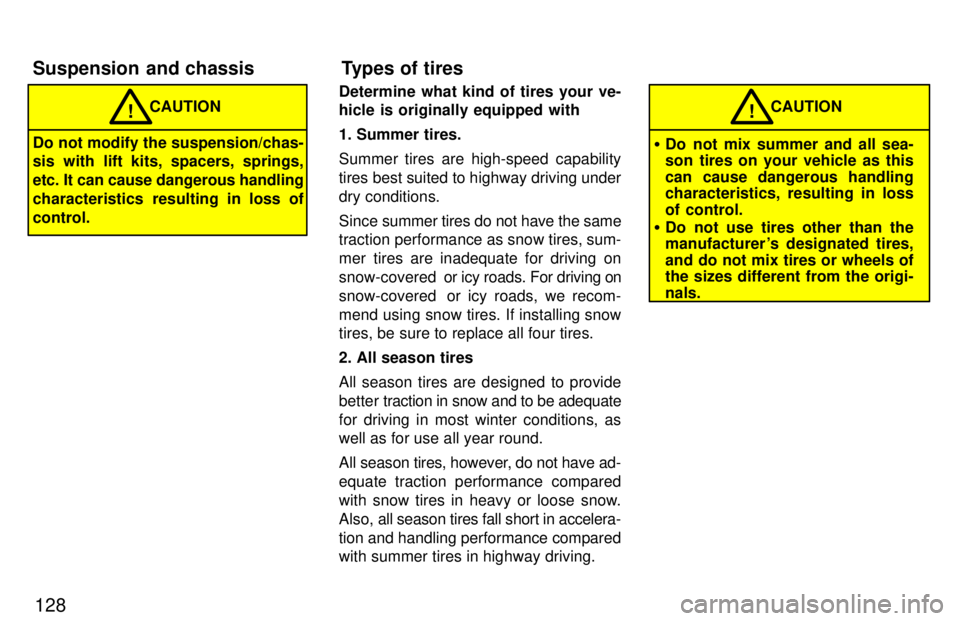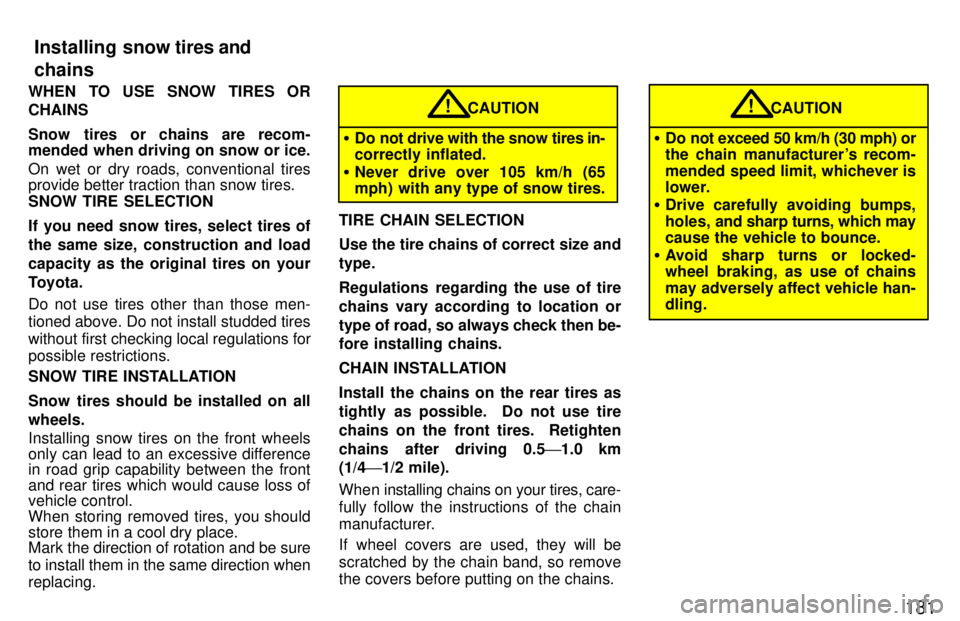1997 TOYOTA LAND CRUISER traction control
[x] Cancel search: traction controlPage 47 of 159

72
Use the four-wheel drive control lever
to select the following transfer modes.
Hº (high speed position, center dif-
ferential unlocked): Lever at Hº
Use this for normal driving on all types of
roads, from dry hard-surfaced roads to
wet, icy or snow-covered roads. This
position gives greater economy, quietest ride, least wear and better vehicle control.
Nº (neutral position): Lever at Nº
No power is delivered to the wheels. Thevehicle must be stopped. Lº (low speed position, four-wheel
drive):
Lever at Lº
Use this for maximum power and traction,
when you experience a loss of power, such as wheel slipping or hard pulling, in the Hº position.
The indicator light tells when the center
differential lock is engaged. Note that the
differential is not s till locked as long as the
indicator light remains off.
If the indicator light does not come on
when the lever is in the Lº position, haveyour vehicle checked by your Toyota deal-
er as soon as possible.
See (b) shifting procedure (with anti-lock brake system)º for further instructions.
In this position, the anti-lock brake sys-
tem does not operate. See Brake sys-
temº in Part 2. To shift between Hº and Lº
, stop the
vehicle, put the transmission into Nº and
move the four-wheel drive control lever.
Never move the four-wheel drive
control lever if wheels are slipping.
Stop the slipping or spinning before
shifting. CAUTION
!
Four-wheel drive systemÐ (a) Four-wheel drive control
(b) Shifting procedure
Page 103 of 159

128
CAUTION!
Do not modify the suspension/chas-
sis with lift kits, spacers, springs,
etc. It can cause dangerous handling
characteristics resulting in loss ofcontrol. Determine what kind of tires your ve-
hicle is originally equipped with 1.
Summer tires.
Summer tires are high-speed capability
tires best suited to highway driving underdry conditions. Since summer tires do not have the same
traction performance as snow tires, sum-
mer tires are inadequate for driving on
snow-covered or icy roads. For driving on
snow-covered or icy roads, we recom-
mend using snow tires. If installing snow tires, be sure to replace all four tires. 2. All season tires
All season tires are designed to provide
better traction in snow and to be adequate
for driving in most winter conditions, as
well as for use all year round.
All season tires, however, do not have ad-
equate traction performance compared
with snow tires in heavy or loose snow.
Also, all season tires fall short in accelera-
tion and handling performance compared with summer tires in highway driving.CAUTION!
� Do not mix summer and all sea-
son tires on your vehicle as this
can cause dangerous handling
characteristics, resulting in loss
of control.
� Do not use tires other than the
manufacturer 's designated tires,
and do not mix tires or wheels of the sizes different from the origi- nals.
Suspension and chassis Types of tires
Page 150 of 159

181
WHEN TO USE SNOW TIRES OR CHAINS
Snow tires or chains are recom-
mended when driving on snow or ice.
On wet or dry roads, conventional tires
provide better traction than snow tires. SNOW TIRE SELECTION
If you need snow tires, select tires of
the same size, construction and loadcapacity as the original tires on your
Toyota.
Do not use tires other than those men-
tioned above. Do not install studded tires
without first checking local regulations for
possible restrictions.
SNOW TIRE INSTALLATION
Snow tires should be installed on all wheels. Installing snow tires on the front wheels
only can lead to an excessive difference
in road grip capability between the front
and rear tires which would cause loss of
vehicle control.
When storing removed tires, you should
store them in a cool dry place.
Mark the direction of rotation and be sure to install them in the same direction when replacing.
CAUTION!
� Do not drive with the snow tires in- correctly inflated.
� Never drive over 105 km/h (65
mph) with any type of snow tires.
TIRE CHAIN SELECTION
Use the tire chains of correct size and type.
Regulations regarding the use of tire
chains vary according to location or
type of road, so always check then be-
fore installing chains.
CHAIN INSTALLATION
Install the chains on the rear tires as
tightly as possible. Do not use tire
chains on the front tires. Retighten
chains after driving 0.5 '1.0 km
(1/4 '1/2 mile).
When installing chains on your tires, care- fully follow the instructions of the chain
manufacturer.
If wheel covers are used, they will be
scratched by the chain band, so remove the covers before putting on the chains.
� Do not exceed 50 km/h (30 mph) or
the chain manufacturer's recom-
mended speed limit, whichever is
lower.
� Drive carefully avoiding bumps,
holes, and sharp turns, which may
cause the vehicle to bounce.
� Avoid sharp turns or locked-
wheel braking, as use of chains
may adversely affect vehicle han- dling.
CAUTION!
Installing
snow tires and
chains
Page 159 of 159

202This
information has been prepared in ac-
cordance with regulations issued by the
National Highway Traffic Safety Adminis-
tration of the U.S. Department of Trans-
portation. It provides the purchasers and/
or prospective purchasers of Toyota
vehicles with information on uniform tire
quality grading.
Your Toyota dealer will help answer any
questions you may have as you read this information.
DOT quality gradesÐAll passenger
vehicle tires must conform to Federal
Safety Requirements in addition to these grades. These quality grades are
molded on the sidewall.
Treadwear ÐThe treadwear grade is a
comparative rating based on the wear
rate of the tire when tested under con-
trolled conditions on a specified govern-
ment test course. For example, a tire
graded 150 would wear one and a half
(1-1/2) times as well on the government course as a tire graded 100. The relative
performance of tires depends upon the
actual conditions of their use, however,
and may depart significantly from the norm due to variations in driving habits,
service practices and differences in road characteristics and climate.
Traction A, B, C ÐThe traction grades,
from highest to lowest, are A, B, and C, and they represent the tire's ability to stop
on wet pavement as measured under
controlled
conditions on specified govern-
ment test surfaces of asphalt and con-
crete. A tire marked C may have poor trac-
tion performance.
Warning: The traction grade assigned to this tire is based on braking (straight
ahead) traction tests and does not include
cornering (turning) traction.
Temperature A, B, C ÐThe temperature
grades are A (the highest), B, and C, rep-
resenting the tire's resistance to the gen-
eration of heat and its ability to dissipate heat when tested under controlled condi- tions on a specific indoor laboratory test
wheel. Sustained high temperature cancause the material of the tire life, and ex- cessive temperature can lead to sudden
tire failure. The grade C corresponds to a level of performance which all passenger
car tires must meet under the Federal Mo-
tor Vehicle Safety Standard No. 109.
Grades B and A represent higher levels of
performance on the laboratory test wheel
than the minimum required by law. Warning: The temperature grades for thistire
are established for a tire that is proper-
ly inflated and not overloaded. Excessivespeed, underinflation, or excessive load- ing, wither separately or in combination,can cause heat buildup and possible tire failure.
Uniform tire quality grading